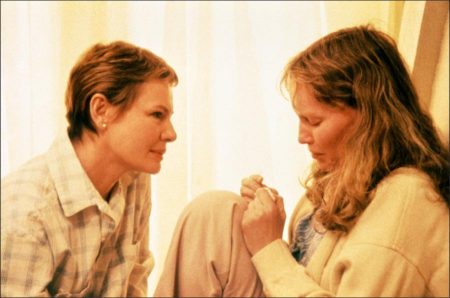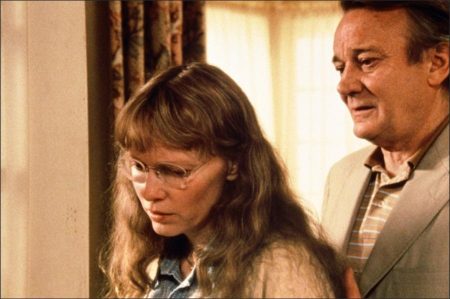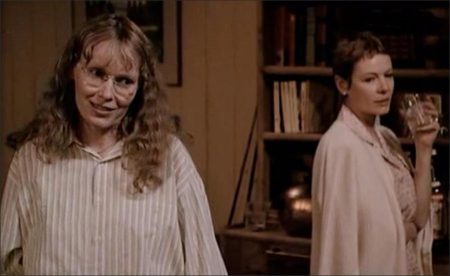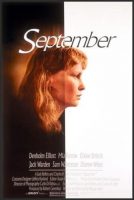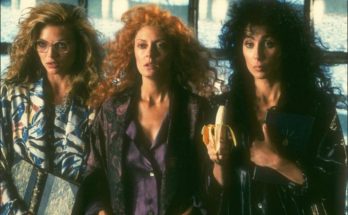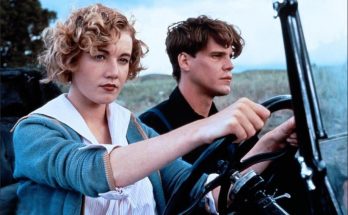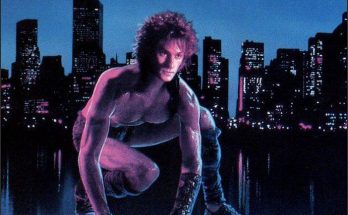September movie synopsis. After a failed suicide attempt, Lane has moved into her country house to recuperate in Vermont. Her best friend, Stephanie, has come to join her for the summer to have some time away from her husband. Lane’s brassy, tactless mother, Diane, has recently arrived with her physicist husband, Lane’s stepfather. Lane is close to two neighbors: Peter, a struggling writer, and Howard, a French teacher. Howard is in love with Lane, Lane is in love with Peter, and Peter is in love with Stephanie.
Diane, once a well-known actress, wants Peter to write her biography, primarily because, many years earlier, a teenage Lane supposedly shot her mother’s abusive lover. Lane does not want this painful event to go back in the spotlight, but Peter thinks it would make a great story.
One evening, Diane decides to host a party, ruining Lane’s plans with Peter. Peter arrives early and confesses to Stephanie that he has wanted to be alone with her for a long time. Outside, there is an electrical storm, and the lights go out. Candles and piano music create a romantic setting. Diane finds her old Ouija board and talks to the spirits of her previous lovers.
A very drunk Howard finally reveals his feelings to Lane, who does not return them. Peter tells Lane that he does not share her feelings. Lane seems to take the rejection well. When everyone else has gone to bed, Peter tries seducing Stephanie, but she is conflicted, later following him back to his house.
September is a 1987 film written and directed by Woody Allen. The film is modeled on Anton Chekhov’s play Uncle Vanya, though the gender roles are often subverted. Starring are Elaine Stritch, Dianne Wiest, Denholm Elliott, Mia Farrow, Sam Waterston, Jack Warden, Rosemary Murphy, Jane Cecil and Ira Wheeler.
Allen’s intention for September was that it be like “a play on film,” hence the great number of long takes and few camera effects. The movie does not use Allen as an actor, and is one of his straightforwardly dramatic films. Woody Allen shot the film twice. It originally starred Sam Shepard as Peter (after Christopher Walken shot a few scenes, but was determined not to be right for the role), Maureen O’Sullivan as Diane, and Charles Durning as Howard. After editing the film he decided to rewrite it, recast it, and reshoot it. He has since stated he would like to redo it again.
Film Review for September
After Woody Allen watched the first version of ”September,” his new film opening Dec. 18, he went out and filmed it all over again – rethought, rewritten and, because time, tide and actors wait for no man, substantially recast. While this may seem an oddity to many, it was perfectly natural to Mr. Allen, who says, ”I usually reshoot tons of material,” and adds perfectly calmly, ”The fact is, I’d like to shoot ‘September’ a third time.”
If a horse player were to describe ”September,” he would say it is by ”Hannah and Her Sisters” out of ”Interiors.” It centers on the wishful or actual relationships of six people in a summer house: a mother (Elaine Stritch) and her daughter (Mia Farrow), with a traumatic past that has caused great bitterness; the daughter’s best friend (Dianne Wiest), whose own life is in turmoil and who has come for a visit; an advertising copywriter with aspirations of writing a book who has rented the guest house on the property (Sam Waterston); an older neighbor who yearns for the daughter (Denholm Elliott); and the mother’s present husband, an earthy physicist (Jack Warden). A true screen play, the film takes place entirely in the house.
”I’ve always wanted to make some chamber pieces with a small cast in one location, and one way to do that is to work in play form deliberately,” Mr. Allen said on a recent Saturday in his Manhattan apartment. Dressed in a tweed coat over a sweater and loosely knotted tie, he was taking a few hours of time off from the untitled film he is now shooting weekdays and simultaneously editing in the evenings and on weekends.
Unlike plays that are written for the stage and then adapted for film, often with less than satisfactory results, ”September,” Mr. Allen said, is, ”I hope, not stagey, because it was conceived for film. It was shot as a film is shot. The perspective of the audience is forever changing, whereas in a play it can’t, and the camera can come in very close and can change a number of times within the same shot. These are the standard tools of a movie. Also, this film never has to live up to any success it had on the stage or any of the practicalities of the stage.”
The story is a drama with flashes of comedy that spring from the characters’ personalities. If that and the action taking place in the country sound reminiscent of, say, Chekhov or Turgenev, it is not completely unintentional, even though a summer house is an unlikely spot for Mr. Allen’s attention. He is well-known as the quintessential New Yorker who feels there is quite enough nature in Central Park and that trips to the country should be avoided if possible and kept brief if necessary (”The crickets make me nervous,” he said some years ago). But Miss Farrow, the mother of eight and his companion of seven years, owns a home in Connecticut.
”She’s forever trying to get me to go up there and enjoy it and I always have a hard time enjoying the country,” he said with a small laugh. ”One day we were strolling around her place and she said, ‘This would make a great setting for a little Russian play or something. It’s just so perfect. It would be fun to shoot up here. The kids would love it and you would have something to do all the time.’ And I thought, what a Chekhovian atmosphere this is. It’s a house on many acres, isolated by itself on a little piece of water. There are trees and a field here and a swing there. It suggested to me right away the kind of stories of Turgenev and Chekhov, which have a certain amount of comedy in them. It’s not real comedy but, I guess, comedy of desperation and anxiety.”
While Miss Farrow’s country home was the inspiration for the setting, Mr. Allen said the story was one that ”I had kicked around for years, that a traumatic incident will happen in one’s life and there are kinds of personalities that just simply get wrecked by it and there are other kinds of personalities that it just washes off them. The interesting thing to me was not the incident itself, which is irrelevant to me and why I never bothered to show it in flashback or write the story about it. What was interesting to me was the long-term responses.”
Although Miss Farrow came close to luring Mr. Allen into an extended stay in the country, other factors intervened. The most imposing, he said, was that ”when it came down to actually scheduling the shooting, it would have brought us up there in winter, and the bare trees and the cold were not the feel I wanted.”
Instead, Santo Loquasto, Mr. Allen’s production designer for the past two films, conceived a set that brings the audience into the rooms of a summer place built on a soundstage. The outdoors is never seen. Rather, it is suggested by light or dark behind closed venetian blinds and by sound effects and references in the dialogue.
In the original design, Mr. Allen said, ”We tried to simulate the outdoors out the window, so we brought trees into the studio. But that felt artificial – not artificial in the photography, but it had an artificial quality to it. I wanted to focus everybody’s attention more inwardly. I wanted the interaction between the characters to be interesting and to not be distracted by a beautiful sunset out the window or trees rustling. So it was a pleasure to have a set built. And the more internalized we got, the happier I was. We finally decided not to make elaborate shots out the window and simulate the outdoors but just stay, as the athletes say, within ourselves.”
The set was not all that evolved. Originally, the actors were Miss Farrow as the daughter, Maureen O’Sullivan (her actual mother) as the mother, and Dianne Wiest, Denholm Elliott (as the physicist-husband), and Charles Durning (as the neighbor). The writer was Christopher Walken, whom Mr. Allen calls ”one of my favorite actors. I used him in ‘Annie Hall’ and was dying to use him again. I think he’s a great, inspired actor.” But as sometimes happens between directors and actors, Mr. Allen said, after a few weeks of shooting, ”We couldn’t get copacetic on what to do and decided that instead of his making concessions and my making concessions, we’d work on something else down the line.” So Sam Shepard was brought on, and in 10 weeks the film was done. Sort of.
Mr. Allen’s penchant for reshooting scenes is so integral a part of his creative process that extra weeks for reshoots are budgeted into every film. Even entirely redoing ”September,” he managed to come in only about 20 percent over budget, a cost borne in part by him. ”There is hardly a film ever where I don’t have to dip into my fees,” he said. And as for the seeming magnitude of reshooting an entire film, he shrugged and said, ”There are films I have reshot half of, like ‘The Purple Rose of Cairo,’ that were more expensive.” The final cost of ”September” was just over $10 million; a fairly modest price by today’s standards.
”Interestingly enough, it’s not all that different from what I usually do,” Mr. Allen explained. ”In this case there were a number of speeches that were too stagey and too long, there were a lot of structural things that I wanted to move quicker and faster, and I wanted to bring the tension in earlier. The way I shoot in general, I tend to make long master scenes and do very little cutting between characters. For instance, let’s say the whole first act consists of 15 shots.
You could also have made 115. It’s a matter of individual style. So, if you’re somebody who does a lot of cutting and one performance has a little mistake in it, you can cut to other people and fix things. But if you’re shooting a five minute scene and there’s just the master, if only one sentence is wrong, or one performance goes a little untrue in the middle of one scene, then you have to do the whole thing over again because there’s no way to save yourself with fancy editing.
”Also, inevitably when you’re doing a play, you stage it and block it and see things wrong. I did that before filming, but when I shot it, there were things that colored it in the editing. When I saw the first version, I saw many mistakes and character things I could do better. I didn’t need certain speeches, and certain things needed to be said that weren’t said. This happened 30 times, in all the acts.
”It’s no different than any playwright with a show out of town. In Philadelphia, you sit in the hotel room and rework scenes. I was doing the same thing. It’s just more cumbersome to do it on film.” Mr. Allen added that he’d like to film a third version ”to make some experiments and just see if other relationships can develop. But of course, that’s pure fantasy.”
Even one reshoot played havoc with the cast. When he decided to begin anew, Miss O’Sullivan was hospitalized with pneumonia, and Mr. Shepard and Mr. Durning were involved with longstanding commitments to other projects. Mr. Allen was left with a choice that was actually no choice. ”I could wait for everybody, but I couldn’t wait for everybody because I had a set that was standing. One of the reasons that this movie was a cinch to make twice is that it was on one set and it cost us nothing to go back and use it again.”
September (1987)
Directed by: Woody Allen
Starring: Elaine Stritch, Dianne Wiest, Denholm Elliott, Mia Farrow, Sam Waterston, Jack Warden, Rosemary Murphy, Jane Cecil, Ira Wheeler
Screenplay by: Woody Allen
Production Design by: Santo Loquasto
Cinematography by: Carlo Di Palma
Film Editing by: Susan E. Morse
Costume Design by: Jeffrey Kurland
Set Decoration by: George DeTitta Jr.
Art Direction by: Speed Hopkins
Distributed by: Orion Pictures
Release Date: December 18, 1987
Views: 171
